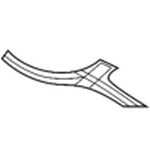Recently, the Beijing High Court made a final judgment on a trademark invalidation case between the appellant Puma Europe Co., Ltd. ("Puma") and the respondent the CNIPA, and the third party in the original trial, Rujun Zuo.
Disputed Mark

Cited Marks

The Beijing High Court found that the Disputed Mark and the Cited Marks are both design marks, and they are similar in design style, composition elements, visual effects, etc. At the same time, according to the advertisements, media reports, sales data, annual income statement, profit and loss statement and other documents submitted by Puma, it can be proved that before the application of the Disputed Mark, each Cited Mark has a certain degree of popularity on "shoes" and other goods. Rujun Zuo, as a competitor in the same industry, should have known about the said information, but failed to fulfill his obligation to reasonably avoid it and still filed for many marks, including the Disputed Mark on identical or similar goods. Such filings could not be regarded as a coincidence. If the Disputed Mark and the Cited Marks are used on identical or similar goods at the same time, it would easily cause the relevant public to mistakenly think that the two were series of trademarks of the same market entity, or that there was some kind of relationship between the two trademark holders, which may lead to misidentification of the source of goods. The difference between the Disputed Mark and the Cited Marks was not enough to eliminate confusion and misunderstanding among the relevant public, and the evidence on record was not sufficient to prove that the Disputed Mark can be distinguished from the Cited Marks after use.
The content of this article is intended to provide a general guide to the subject matter. Specialist advice should be sought about your specific circumstances.

